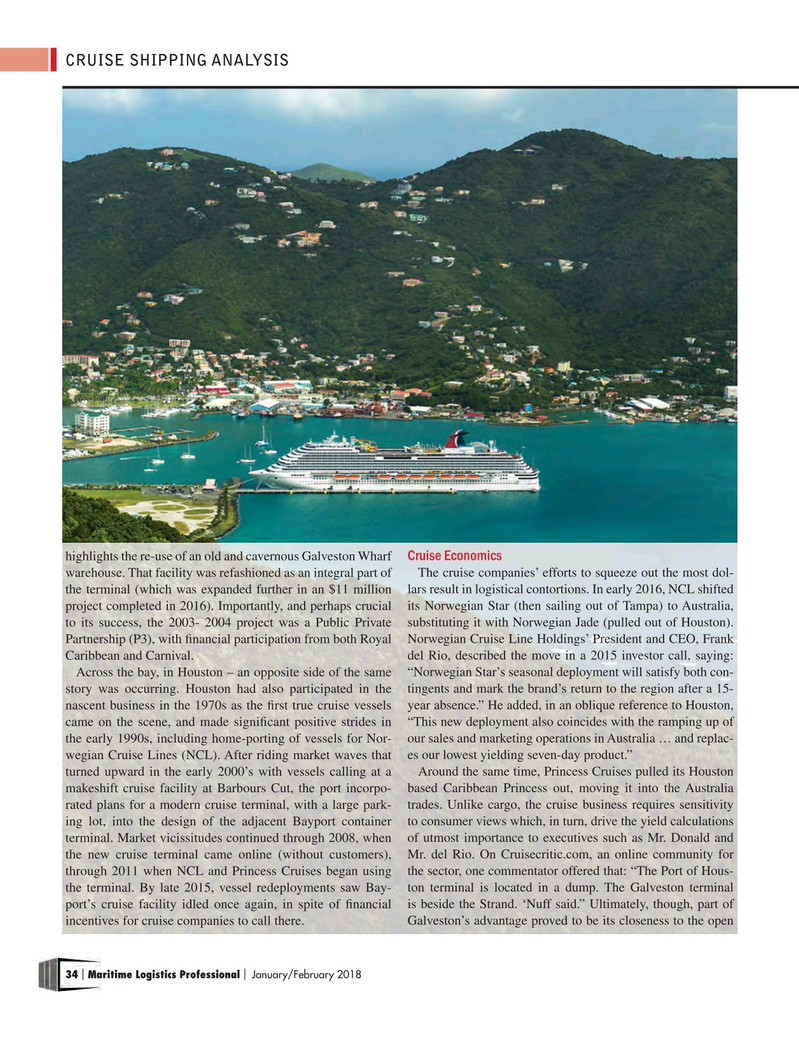
Page 34: of Maritime Logistics Professional Magazine (Jan/Feb 2018)
Cruise Shipping Trends
Read this page in Pdf, Flash or Html5 edition of Jan/Feb 2018 Maritime Logistics Professional Magazine
CRUISE SHIPPING ANALYSIS
Cruise Economics highlights the re-use of an old and cavernous Galveston Wharf warehouse. That facility was refashioned as an integral part of The cruise companies’ efforts to squeeze out the most dol- the terminal (which was expanded further in an $11 million lars result in logistical contortions. In early 2016, NCL shifted project completed in 2016). Importantly, and perhaps crucial its Norwegian Star (then sailing out of Tampa) to Australia, to its success, the 2003- 2004 project was a Public Private substituting it with Norwegian Jade (pulled out of Houston).
Partnership (P3), with ? nancial participation from both Royal Norwegian Cruise Line Holdings’ President and CEO, Frank
Caribbean and Carnival. del Rio, described the move in a 2015 investor call, saying:
Across the bay, in Houston – an opposite side of the same “Norwegian Star’s seasonal deployment will satisfy both con- story was occurring. Houston had also participated in the tingents and mark the brand’s return to the region after a 15- nascent business in the 1970s as the ? rst true cruise vessels year absence.” He added, in an oblique reference to Houston, came on the scene, and made signi? cant positive strides in “This new deployment also coincides with the ramping up of the early 1990s, including home-porting of vessels for Nor- our sales and marketing operations in Australia … and replac- wegian Cruise Lines (NCL). After riding market waves that es our lowest yielding seven-day product.” turned upward in the early 2000’s with vessels calling at a Around the same time, Princess Cruises pulled its Houston makeshift cruise facility at Barbours Cut, the port incorpo- based Caribbean Princess out, moving it into the Australia rated plans for a modern cruise terminal, with a large park- trades. Unlike cargo, the cruise business requires sensitivity ing lot, into the design of the adjacent Bayport container to consumer views which, in turn, drive the yield calculations terminal. Market vicissitudes continued through 2008, when of utmost importance to executives such as Mr. Donald and the new cruise terminal came online (without customers), Mr. del Rio. On Cruisecritic.com, an online community for through 2011 when NCL and Princess Cruises began using the sector, one commentator offered that: “The Port of Hous- the terminal. By late 2015, vessel redeployments saw Bay- ton terminal is located in a dump. The Galveston terminal port’s cruise facility idled once again, in spite of ? nancial is beside the Strand. ‘Nuff said.” Ultimately, though, part of incentives for cruise companies to call there. Galveston’s advantage proved to be its closeness to the open 34 Maritime Logistics Professional January/February 2018 | |

 33
33

 35
35
